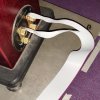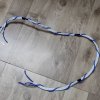I did not get the meaning of close proximity. You mean I should separate the two pairs by a physical distance while running them from source to amp.Check out cable capacitance after you run them in parallel if you lay them in close proximity. It can lead to oscillation if you are running a SS amp.
You are using an out of date browser. It may not display this or other websites correctly.
You should upgrade or use an alternative browser.
You should upgrade or use an alternative browser.
The effect of cables - A sane debate
- Thread starter Hari Iyer
- Start date
Preferably yes to avoid parasitic capacitance from adding up. Having a LCR meter can help here to measure the capacitance.I did not get the meaning of close proximity. You mean I should separate the two pairs by a physical distance while running them from source to amp.
This where the telephone cable helps, as twisting the cores and twisting the +/- polarity helps in reducing capacitance and self inductance.
My 10+ meter cable measured just 500pF and inductance of 10uH.
dheerajin
Well-Known Member
https://perkune.com/audiophile-airgap-isolation
Just for thought process...How airgap can be effective
Just for thought process...How airgap can be effective
Had visited the cable shop for my HT requirement, this IDE data cable caught my attention. With 34 strands, thought of giving it a try as speaker cables. With 80rs/meter it's an inexpensive experiment. Google didn't give much idea, just divided into 17 strands per polarity and connected.
The nordost base cable looks similar with 14strands per polarity AFAIK.
Impressions after 4hrs listening
+ves
Absolutely no harshness
Very detailed LF response
Good vocals
Pretty VFM
-ves
Lack of detailed presentation
Lacks sparkle and airyness
Slightly boomy
Anybody else tried them?

The nordost base cable looks similar with 14strands per polarity AFAIK.
Impressions after 4hrs listening
+ves
Absolutely no harshness
Very detailed LF response
Good vocals
Pretty VFM
-ves
Lack of detailed presentation
Lacks sparkle and airyness
Slightly boomy
Anybody else tried them?

dheerajin
Well-Known Member
I tried cable doubling experiment with speaker cable only for high frequency terminals of the speakers, since they are Bi-amped. I stumbled upon Jeff’s Blog (http://jeffsplace.me) and he mentioned that thin duelund wires are good in carrying high frequency signals and somewhere I read that telecommunication cables which are properly shielded are good for carrying high frequency plus low level information. So got the Belden 89182 communication cable from a friend. Buld quality of this cable superb.
So I tried doubling it with Chord carnival silver screen cable and there was sparkle at high end low level information was appearing that I never heard before and to believe it I tested it with more than 10 songs. So it was evident Chord carnival was not able to deliver high frequency content.
Now next experiment is to take out chord and doubling Belden cable, since I was doing this without banana plugs , so could not do it.
It is for sure that cable geometry and shielding affects the sound frequencies and instead changing the cables , doubling the cable with different AWG can yield better results.
So I tried doubling it with Chord carnival silver screen cable and there was sparkle at high end low level information was appearing that I never heard before and to believe it I tested it with more than 10 songs. So it was evident Chord carnival was not able to deliver high frequency content.
Now next experiment is to take out chord and doubling Belden cable, since I was doing this without banana plugs , so could not do it.
It is for sure that cable geometry and shielding affects the sound frequencies and instead changing the cables , doubling the cable with different AWG can yield better results.
Last edited:
dheerajin
Well-Known Member
All my power cables are based on this article only
This was one of the best success for DIY effort I had in my set of experiments. Though the difference in actual SQ may not be huge, but it was more towards the way I liked my music to sound.
I wanted to use 6sqmm cables(finolex) for DIY power cable and I used a basic cotton strip for insulation. Line & Neutral were insulated but the Earth wire was made to twirl around the two cables. Which was supposed to reduce EMI. Basic guide was from a DIY website, used heat resistant adhesive on the wires to wrap the cotton strip (Pyjama Nada ) for insulation .
) for insulation .
The toughest part was getting those larger cables in basic connector and soldering. I had to cut off the entry point in connectors to make way for 3 wires.
Well the cost? Less than 500, but result was quite satisfactory. Very sweet sound (probably all Copper wire ) with adequate detail. Slightly booming but I can't blame the cable entirely for that. I'm on the look out for better connectors to improvise the solution. It's better than the hi silver power cord I have.


Looks pretty basic but sounds good. Suggestions welcome.
I'd suggest every one to try this mod as it's pretty easy to make & if works for you then a gold mine for sure.
I wanted to use 6sqmm cables(finolex) for DIY power cable and I used a basic cotton strip for insulation. Line & Neutral were insulated but the Earth wire was made to twirl around the two cables. Which was supposed to reduce EMI. Basic guide was from a DIY website, used heat resistant adhesive on the wires to wrap the cotton strip (Pyjama Nada
The toughest part was getting those larger cables in basic connector and soldering. I had to cut off the entry point in connectors to make way for 3 wires.
Well the cost? Less than 500, but result was quite satisfactory. Very sweet sound (probably all Copper wire ) with adequate detail. Slightly booming but I can't blame the cable entirely for that. I'm on the look out for better connectors to improvise the solution. It's better than the hi silver power cord I have.


Looks pretty basic but sounds good. Suggestions welcome.
I'd suggest every one to try this mod as it's pretty easy to make & if works for you then a gold mine for sure.
Hi drkrack
Do not use bare stranded wire in a cotton sleeve. For power applications insulation is a must. Cotton is not an insulator. If humidity is high or there is moisture current can leak. A friend of mine had his amp blown up due to shorting when he used bare copper wires in a cotton sleeve
Also it does not make sense to use a wire thicker than the wire that is in wall. Most of our in wall wire is 2.5 sq mm or 4 sq mm. If your in wall is 6 sq mm it’s fine.
IME going from a thinner in wall wire to a thicker power cable on the outside messes up the sound. Becomes a bit bloated and slow. The only possible advantage could be that impedance of a thicker cable is lower. Hence it helps in the ground. What probably makes more sense is to use wire of the same thickness as the in wall wire for hot and neutral and use a thicker wire for the ground to lower impedance. That IMO is a better design. As in all things audio YMMV
Do not use bare stranded wire in a cotton sleeve. For power applications insulation is a must. Cotton is not an insulator. If humidity is high or there is moisture current can leak. A friend of mine had his amp blown up due to shorting when he used bare copper wires in a cotton sleeve
Also it does not make sense to use a wire thicker than the wire that is in wall. Most of our in wall wire is 2.5 sq mm or 4 sq mm. If your in wall is 6 sq mm it’s fine.
IME going from a thinner in wall wire to a thicker power cable on the outside messes up the sound. Becomes a bit bloated and slow. The only possible advantage could be that impedance of a thicker cable is lower. Hence it helps in the ground. What probably makes more sense is to use wire of the same thickness as the in wall wire for hot and neutral and use a thicker wire for the ground to lower impedance. That IMO is a better design. As in all things audio YMMV
Fiberglass insulation should never be left exposed in an occupied area, according to the American Lung Association. Here I am sure they are not referring to small wires but generally I would avoid fiber glass insulation.
Don't know on what context they have said this. Fiber glass sleeve has highest tensile strength, insulation resistance, heat bearing capacity compared to other materials. If exposure is the only issue, I can cover it with a pvc sleeve if required on top of it.
Why would you need fiber glass? It makes no sense. Just insert your wire in a Teflon tube and you’re done
Why would you need any of the qualities you mentioned for home use? Maybe in a plant where it could be subjected to extreme conditions, I can understand
Why would you need any of the qualities you mentioned for home use? Maybe in a plant where it could be subjected to extreme conditions, I can understand
Fiber glass sleeve is used for additional insulation just in case the enamled gets ripped off. What I can alternatively do is remove the fiber glass sleeve and wrap a cotton cloth adhesive tape on top of the enamled solid copper wire. Maybe it can change sound to the +ve hopefully.Actually since you’re using enamelled wire, you don’t need a sleeve.
Order your Rega Turntables & Amplifiers from HiFiMART.com - India's reputed online dealer.

